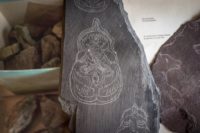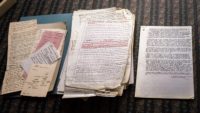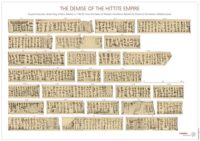 In a shocking development, researchers have discovered that James Mellaart, the archaeologist who first excavated one of the most important prehistoric sites in the world, the 9,000-year-old Neolithic proto-urban settlement of Çatalhöyük in Turkey, for decades fabricated murals and inscriptions, passing them off as genuine finds and publishing them extensively.
In a shocking development, researchers have discovered that James Mellaart, the archaeologist who first excavated one of the most important prehistoric sites in the world, the 9,000-year-old Neolithic proto-urban settlement of Çatalhöyük in Turkey, for decades fabricated murals and inscriptions, passing them off as genuine finds and publishing them extensively.
James Mellaart, who died in 2012, created some of the “ancient” murals at Çatalhöyük that he supposedly discovered; he also forged documents recording inscriptions that were found at Beyköy, a village in Turkey, said geoarchaeologist Eberhard Zangger, president of the Luwian Studies Foundation. Zangger examined Mellaart’s apartment in London between Feb. 24 and 27, finding “prototypes,” as Zangger calls them, of murals and inscriptions that Mellaart had claimed were real.
“He used the same approach for over 50 years,” Zangger told Live Science. “He would first acquire a tremendously broad and deep knowledge [about the area he was interested in]. Then, he would try to use this knowledge to develop a coherent historic panorama,” Zangger said. This process in itself is not uncommon for an archaeologist or historian. The only difference is that legitimate researchers then look for evidence that either supports or refutes their ideas. Instead, “Mellaart would fabricate drawings of artifacts and translations of alleged documents to reinforce his theories,” Zangger said.
 But perpetrating multiple frauds in defense of his own conclusions, as appalling as that is, isn’t even the worst of it. His deceptions went beyond the grave, his own and other people’s. He manipulates scholars who trusted and respected him into keeping his long undetected record of forgery and fiction passed off as fact unbroken after his death, and he put many of these lies in the mouths of dead colleagues who could no longer defend their reputations.
But perpetrating multiple frauds in defense of his own conclusions, as appalling as that is, isn’t even the worst of it. His deceptions went beyond the grave, his own and other people’s. He manipulates scholars who trusted and respected him into keeping his long undetected record of forgery and fiction passed off as fact unbroken after his death, and he put many of these lies in the mouths of dead colleagues who could no longer defend their reputations.
Last year, Mellaart’s estate sent the Luwian Studies Foundation a number of documents containing “ancient texts” which Mellaart had singled out as being of special significance and worthy of immediate publication. LSF experts were tasked by the estate with researching those texts further. One of them was a very long inscription from Beyköy that doesn’t exist. The sole evidence that it ever existed was a drawing and transcription of the lost stone done by archaeologist Georges Perrot in 1878. Perrot’s purported copy of the inscription was in Mellaart’s notes. Eberhard Zangger and independent researcher Fred Woudhuizen published that inscription in the December 2017 issue of Proceedings of the Dutch Archaeological and Historical Society.
 This publication made headlines at the time because the inscription touched on one of those subjects that the mainstream press gets excited about: Troy. Now the Luwian Society can’t tell if it’s authentic or not (I vote most definitely not), because so many of Mellaart’s Beyköy inscriptions have proven to be forgeries complete with multiple drafts and clear evidence of the fabrication process.
This publication made headlines at the time because the inscription touched on one of those subjects that the mainstream press gets excited about: Troy. Now the Luwian Society can’t tell if it’s authentic or not (I vote most definitely not), because so many of Mellaart’s Beyköy inscriptions have proven to be forgeries complete with multiple drafts and clear evidence of the fabrication process.
Zangger said he feels betrayed by the fact that Mellaart asked researchers to publish his forgeries for him after his death. “I feel abused,” Zangger said. Correspondence found in his apartment indicate that Mellaart tried to get others interested in publishing the forgeries before he died, Zangger said, adding that “he had no scruples when it came to harming other people’s careers.”
Oh, and Mellaart first contacted Zangger about the Beyköy inscriptions in 1995, claiming he couldn’t read Luwian (an ancient Anatolian language group) and asking Zangger to translate them for him. Zangger discovered when he went through the papers in Mellaart’s apartment that in fact he had an excellent command of Luwian, so he was setting him up as the patsy more than two decades ago.
I came very close to writing about two of these frauds, the ostensible Trojan inscription and an ostensible volcano mural. I dodged those bullets for two reasons: a) the “finds” seemed tenuous to me and 2) there were no proper high res pictures. Not that I ever suspected Mellaart had spent decades as a committed fabulist keen to drag unwitting colleagues into his web of delusion, deceit and a disregard for professional ethics so enormously flagrant that it transcended even his own death. That had not occurred to me. I just thought there was too much speculation based on very limited hard evidence, something you see all the time in archaeological stories, and I discard a dozen interesting articles a day because the photos suck. Never have I been happier to be obsessed with scoring big pics.